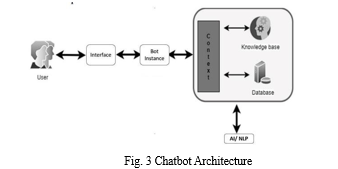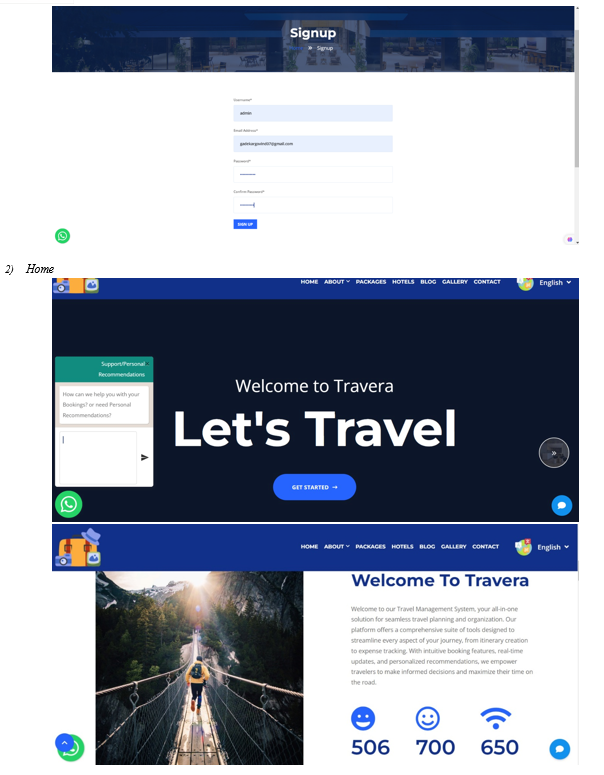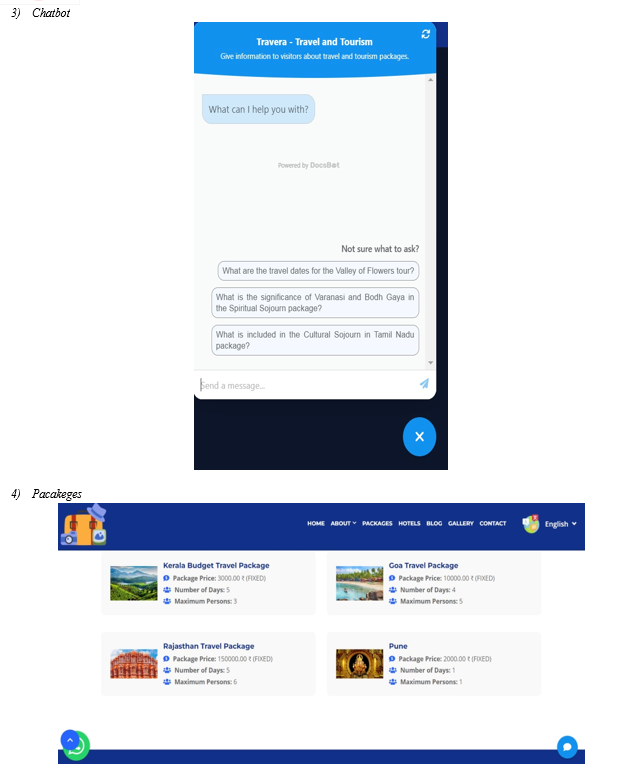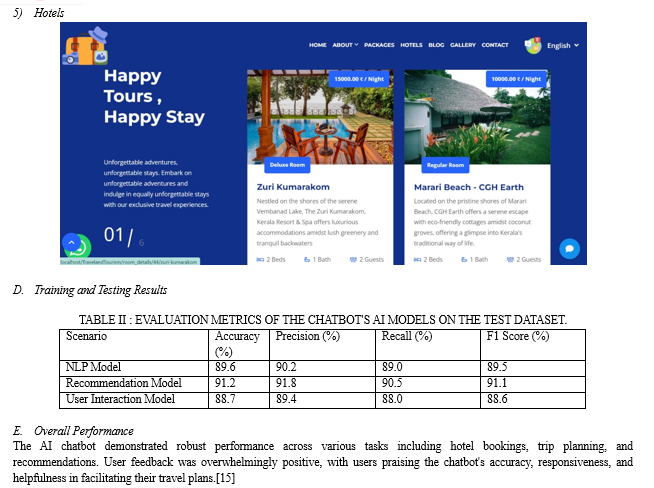Ijraset Journal For Research in Applied Science and Engineering Technology
- Home / Ijraset
- On This Page
- Abstract
- Introduction
- Conclusion
- References
- Copyright
Travel and Tourism Management System Using Chatbot Recommender
Authors: K. T. Mohite, Mayuri Borse, Govinda Gadekar, Sakshi Hon, Sharayu Jagtap
DOI Link: https://doi.org/10.22214/ijraset.2024.60581
Certificate: View Certificate
Abstract
The importance of chatbots has surged in both research and practical applications, exemplified by widely used platforms such as Amazon’s Alexa and Apple’s Siri. This paper introduces the methodologies and technologies underpinning a chatbot tailored for e-tourism, facilitating textual communication to aid in hotel bookings, trip planning, and recommendations for noteworthy sights. Specifically, we explore the integration of model-based reasoning to elevate user interaction, particularly in scenarios featuring an overwhelming array of choices or where user preferences are excessively restrictive, leading to inconsistencies and unattainable responses. Additionally, we offer a use case within the tourism domain to demonstrate the practical efficacy of such a model-based chatbot.
Introduction
I. INTRODUCTION
The global interest in exploring diverse cultures, lifestyles, cuisines, landmarks, and historical sites has led to a surge in international tourism [1]. In recent decades, there has been a notable increase in outbound travel from India, with the number of travelers rising from 4.42 million in 2000 to 26.9 million in 2019. However, due to the COVID-19 pandemic, there was a decline to 7.29 million in 2020 [2]. This trend can be attributed to the growth in per capita income, which rose from $443 per annum in 2000 to $2101 in 2020, resulting in an expanded middle and upper-class demographic [3].
As the tourism market expanded, various facilitators such as MakeMyTrip [4], TripAdvisor [5], EaseMyTrip [6], and Yatra [7] emerged to cater to the growing demand. Traditional methods of destination selection involve analyzing reviews on platforms like MakeMyTrip and TripAdvisor, as well as social media platforms such as Twitter [8], Facebook (Meta) [9], Instagram [10], and YouTube [11]. Travel bloggers often share detailed information, including hotel recommendations, weather conditions, popular attractions, and , to assist prospective travelers. Additionally, many countries provide tourism-related information on their official websites, aiding travelers in planning their trips. However, the abundance of text reviews poses challenges, including their length and sheer volume, making manual analysis tedious and time-consuming. Furthermore, relevant information is dispersed across multiple platforms, complicating comprehensive exploration. Thus, there is a need for automated mechanisms to extract and summarize these reviews efficiently, addressing specific user preferences.
The proposed framework employs Big Data technology to extract and analyze natural language reviews from platforms such as TripAdvisor, YouTube, and Twitter. The analysis generates a destination score based on five key factors: availability of vegetarian food, hotel facilities, comfort, sightseeing & attractions, and family friendliness. These factors are crucial considerations for travelers when selecting destinations. The framework focuses on the top 10 destinations favored by Indian tourists in recent years.
To gather data, Selenium [13][14] and BeautifulSoup [15][16] are utilized to filter reviews from trusted sources, specifically targeting restaurants with vegetarian options, family-friendly hotels, common facilities, attractions, and comfort ratings. The resultant data, characterized by its volume, heterogeneity, and high velocity, poses a Big Data challenge, addressed using Apache Spark [17].
The extracted data undergoes preprocessing using the Natural Language Toolkit (NLTK) [18], followed by sentiment analysis using pre-trained BERT models [19]. The framework then utilizes the sentiment analysis results to train a chatbot recommendation system. This chatbot provides personalized destination recommendations based on user preferences and suitability for their families.
The framework finally presents the results in a user-friendly visual format, allowing users to explore destinations based on their preferences and the recommendations provided by the sentiment analysis-powered chatbot
II. LITERATURE REVIEW
Current tourism recommendation techniques exhibit various innovative aspects and can be categorized based on their approach to analyzing user information and filtering item lists [14].
A. Collaborative Filtering
One approach, collaborative filtering, aims to recommend destinations to users based on the preferences and habits of similar user profiles [15]. For instance, the VISIT system [11] employs sentiment analysis techniques, such as the Alchemy Application Programming Interface (API), to assess feedback about attractions on platforms like Twitter and Facebook. However, matching users' travel histories accurately can be challenging, as finding individuals with identical travel experiences is often impractical. Collaborative filtering also faces limitations in handling varying trip durations, diverse interests, and evolving preferences among users.
B. Content-based Recommender System
Content-based systems analyze content similarities between items previously examined by users and those yet to be explored [16, 17]. Although widely used, they require a comprehensive representation of item content, posing a challenge in the tourism domain due to the extensive and varied nature of tourist attractions [14, 18]. Additionally, they may suffer from overspecialization, recommending experiences solely based on past interactions without considering evolving preferences [19]. However, advancements in natural language processing and machine learning techniques have enabled more nuanced content analysis, enhancing the accuracy of recommendations.
C. Context-aware Filtering
Context-aware recommender systems leverage contextual information, such as geolocation and weather, to predict user interests [11]. These systems utilize data from connected devices and social networks to enrich user context [20]. However, implementing such systems requires robust context modeling and integration with tourism content repositories. Context-aware filtering addresses the dynamic nature of travel preferences by considering real-time factors like weather conditions, user location, and historical visit patterns.
D. Hybrid Recommender System using Chatbot
Hybrid approaches, combining multiple techniques, aim to overcome individual method limitations and leverage their strengths [20]. For example, a hybrid recommender system architecture integrates content-based, social-based, and context-based approaches to provide personalized recommendations [20]. By combining collaborative filtering with content-based and context-aware techniques, hybrid systems offer more comprehensive and accurate recommendations, catering to diverse user preferences and situational contexts.
E. Discussion
Despite advancements, current solutions predominantly focus on specific categories of items, such as hotels or tourist sites, and rely heavily on content-based approaches [14, 18]. Hence, there is a need for a unified conceptual framework that integrates diverse recommendation approaches and presents tourism resources comprehensively in a single architecture. Such a framework could leverage the strengths of different techniques while mitigating their individual limitations, ultimately enhancing the effectiveness and user experience of tourism recommendation systems. Further research and development in this area are essential to address the evolving needs and preferences of travelers in an increasingly interconnected and dynamic world.
III. REFERENCE ARCHITECTURE
Our research introduces a pioneering architecture for tourism recommender systems, emphasizing a hybrid recommendation approach to enrich user access to tourism resources within information retrieval systems like tourism portals and service providers' documentary Extranets. Unlike conventional systems that merely provide a list of recommended tourist attractions, our architecture functions as a comprehensive planner, aiming to craft detailed multi-day visit itineraries tailored to individual preferences.
The proposed system architecture comprises five main modules, as illustrated in Figure 1:
- Visitor Profiles: Visitor profiles contain essential information that can be utilized to discern user preferences regarding items, encompassing ratings, social information, and other pertinent data. These profiles serve as the foundation for generating personalized recommendations aligned with user interests and preferences.[15]
- Services Repository: The services repository hosts a wealth of information on tourist services, spanning accommodations, restaurants and tourist sites options. Additionally, it stores associated multimedia content, enriching the user experience and providing comprehensive insights into available tourism offerings.
- Contextual Meta-Model: The contextual meta-model integrates various contextual factors crucial for recommendation generation, including time, space, location, distance between locations, travel history, and user preferences. By considering these contextual cues, the system can deliver contextually relevant recommendations tailored to the user's current situation and preferences.
- Hybrid Filtering Process: The hybrid filtering process employs a blend of recommendation techniques to generate a curated list of items, along with corresponding degrees of user appreciation for each item. By combining collaborative filtering, content-based filtering, and other methodologies, the system ensures a holistic and accurate recommendation process, catering to diverse user preferences.[11]
- Chatbot Trip Planner: The Chatbot trip planner module selects items deemed relevant to the user's preferences and constructs cohesive travel itineraries using operational research techniques. By correlating recommended items such as tourist attractions, accommodations, and activities, the trip planner creates comprehensive and personalized travel plans optimized for user satisfaction and enjoyment.
Overall, our proposed architecture for tourism recommender systems represents a comprehensive and innovative approach to enhancing the user experience in accessing tourism resources. By leveraging hybrid recommendation techniques and incorporating contextual factors, the system aims to provide tailored recommendations and facilitate seamless travel planning for users.

IV. METHODOLOGY
A. Data Collection
Data collection involved gathering relevant information to train and develop the AI chatbot. This included collecting user queries, product information, feedback, and other relevant data sources. Various channels such as customer interactions, online forums, social media platforms, and existing databases were utilized for data collection.[18] The collected data was preprocessed to remove noise, duplicates, and irrelevant information to ensure data quality.
B. Tools and Technologies
Natural Language Processing (NLP) libraries such as NLTK (Natural Language Toolkit), spaCy, and Gensim were used for text analysis and understanding. Machine learning frameworks such as TensorFlow and TextBlob were employed for training AI models.[11] Development platforms such as Python were chosen for building the chatbot's backend infrastructure. An evaluation of chatbot development frameworks like Microsoft Bot Framework, Dialogflow and Rasa was conducted for creating the chatbot's conversational capabilities. Database systems such as MySQL and MongoDB were used for storing and managing data.
C. Experimental Design
The development process followed an iterative and incremental approach, starting with a basic prototype and gradually adding features and functionalities. User stories and use cases were defined to outline the expected behavior and interactions of the chatbot with users.[19] A test-driven development (TDD) approach was adopted, where unit tests and integration tests were written before implementing new features or modifications. Continuous integration and deployment (CI/CD) pipelines were set up to automate the testing and deployment processes, ensuring a streamlined development workflow.
D. Implementation Approach

The implementation of the AI chatbot began with designing the architecture and framework as depicted in Figure 3.
The chatbot's user interface and natural language processing engine were developed as separate components, facilitating modularization and scalability. NLP and AI techniques, including NLU and NLG, were employed to analyze user queries and generate appropriate responses.[20] Various AI algorithms, such as reinforcement learning, supervised learning, and unsupervised learning, were utilized to train the chatbot and improve its efficiency and accuracy.
Features and functionalities of the chatbot, such as 24-hour availability, and personalized recommendations, were implemented to meet user expectations and needs. User interface and user experience (UI/UX) design principles guided the development of an intuitive and user-friendly interface for seamless interaction with the chatbot.
E. Justification
The chosen methodology aligns with industry best practices for developing AI-powered chatbots, ensuring robustness, scalability, and usability. Iterative development allows for continuous feedback and improvement, enhancing the chatbot's performance over time.[05] The use of advanced NLP and AI techniques enables the chatbot to understand and respond to user queries effectively, enhancing user satisfaction and engagement. Continuous testing and integration ensure the reliability and stability of the chatbot throughout the development lifecycle. Deviations from standard practices, if any, were justified based on specific project requirements, technological constraints, or user feedback.
V. IMPLEMENTATION
A. Chatbot
- Data Collection and Preprocessing: Collect user reviews, ratings, and other relevant data from various sources such as online forums, social media platforms, and databases.Preprocess the collected data to remove noise, duplicates, and irrelevant information using NLP libraries like NLTK, spaCy.
- Sentiment Analysis Model Training: Train a sentiment analysis model using machine learning frameworks such as TextBlob.Use the preprocessed data to train the model to classify user sentiment as positive, negative, or neutral.[14]
- Chatbot Architecture and Framework : :Design the chatbot architecture based on the proposed system architecture, including modules for visitor profiles, services repository, contextual meta-model, hybrid filtering process, and trip planner. valuate chatbot development frameworks like Microsoft Bot Framework, Dialog flow for creating conversational capabilities.
- Implementation Approach: Develop separate components for the chatbot's user interface and natural language processing engine.[10] Utilize NLP and AI techniques such as Natural Language Understanding (NLU) and Natural Language Generation (NLG) to analyze user queries and generate appropriate responses.. Implement various AI algorithms (e.g., reinforcement learning, supervised learning, unsupervised learning) to train the chatbot and improve its efficiency and accuracy. .Incorporate features and functionalities such as multilingual support, 24-hour availability, and personalized recommendations to meet user expectations.
- User Interaction : Design an intuitive and user-friendly interface for seamless interaction with the chatbot.. Ensure the chatbot's UI follows UI/UX design principles for clarity, consistency, and simplicity .Enable the chatbot to communicate with users using natural language and a conversational tone.
- Sentiment-Based Recommendation Generation: Integrate the trained sentiment analysis model into the chatbot to understand user sentiment from their queries and feedback.. Use the sentiment analysis results to generate personalized tourism recommendations aligned with user preferences and interests.[09]
- Deployment and Evaluation : Deploy the chatbot on suitable platforms or channels to make it accessible to users.. Monitor the chatbot's performance and gather user feedback to assess its effectiveness and user satisfaction. .Iterate on the design and implementation based on user feedback and evolving requirements.
B. Tourism Reviews Sentiment Analysis Web Application
- Initialize :Import necessary libraries: streamlit, pandas, numpy, textblob, wordcloud, matplotlib, scikit-learn.Set Streamlit options.
- Input Data: Allow the user to upload a CSV file containing tourism reviews.
- Perform Sentiment Analysis :For each review in the dataset. Calculate the sentiment polarity using TextBlob. .Classify the sentiment as positive, negative, or neutral based on the polarity.
- Data Exploration: Display the distribution of sentiment across reviews using a bar chart and a histogram.[18]
- Word Cloud Visualization : Generate word clouds for each sentiment category (positive, negative, neutral) to visualize frequent words in reviews.
- Model Training and Evaluation :Split the data into training and testing sets. Vectorize the text data using TF-IDF. Train a decision tree classifier. Evaluate the model's performance using accuracy, precision, recall, F1 score, confusion matrix, and ROC curve.[10]
- Decision Tree Visualization: Visualize the decision tree classifier to understand its decision-making process.
- User Input and Prediction: Allow the user to input their own review Predict the sentiment of the input text using the trained model.
- Display Output: Display the results, including sentiment distribution, word clouds, model evaluation metrics, and the prediction for user input.
- Run the Application: Run the Streamlit web application to interact with users and provide functionality for sentiment analysis on Tourism reviews.[12]
C. Challenges Faced
- Data Collection and Processing
Challenge: Gathering and processing large volumes of text data from diverse sources such as TripAdvisor, YouTube, and social media platforms posed challenges in terms of data quality, noise, and preprocessing.
Address: Robust data cleansing and preprocessing techniques were implemented using libraries like NLTK (Natural Language Toolkit) and BeautifulSoup. This involved removing noise, duplicates, and irrelevant information to ensure data quality. Additionally, advanced text analysis techniques were employed to extract relevant features and insights from the collected data.
2. Integration of Model-Based Reasonin
Challenge: Integrating model-based reasoning techniques to enhance user interaction and deci sion-making posed challenges in terms of seamless integration with the chatbot's architecture and ensuring consistent performance across different scenarios.
Address: Careful design and implementation of model-based reasoning components were conducted, ensuring compatibility with the chatbot's architecture.[10] Iterative development and testing processes were employed to refine the model's performance and address any inconsistencies or limitations. User feedback was actively solicited and incorporated into the refinement process to ensure the model's effectiveness in real-world scenarios.[20]
3. User Interface Design
Challenge: Designing an intuitive and user-friendly interface for the chatbot posed challenges in terms of balancing simplicity with functionality and ensuring a seamless user experience across different devices and platforms.
Address: Usability testing and feedback sessions were conducted with target users to identify pain points and usability issues. Iterative design iterations were performed based on user feedback, focusing on improving clarity, consistency, and simplicity in the chatbot's UI/UX design. Additionally, responsive design principles were applied to ensure compatibility across various devices and screen sizes.[05]




Conclusion
The integration of AI chatbots into customer service systems holds promise for enhancing consumer experiences.[18] Our investigation demonstrated that AI chatbots offer advantages such as prompt responses, higher completion rates, improved customer satisfaction metrics, and reduced operational costs compared to conventional methods. These findings underscore the potential of AI chatbots to revolutionize customer service practices and contribute to the broader business landscape.[19] Moving forward, further research will delve into the impact of AI and natural language processing on chatbot effectiveness and performance in customer service settings.[10] Additionally, investigations may explore the ramifications of these technologies on employee job satisfaction and workload management. The evolution of AI-powered chatbots is poised to reshape business-consumer interactions significantly. As technological capabilities progress, these systems will become increasingly adept at delivering exceptional customer service, making them indispensable tools for forward-thinking enterprises[09]
References
[1] L. Sebastia, I. Garc´?a, E. Onaindia, and C. Guzman Alvarez, ´ e-Tourism: A tourist recommendation and planning application, International Journal on Artificial Intelligence Tools, vol. 18, no. 5, pp. 717– 738, 2009. [2] F. Ricci, L. Rokach, and B. Shapira, Introduction to recommender systems handbook, in Recommender Systems Handbook, F. Ricci, L. Rokach, B. Shapira, and P. Kantor, eds. Boston, MA, USA: Springer, 2011, pp. 1–35. [3] G. Adomavicius and A. Tuzhilin, Toward the next generation of recommender systems: A survey of the stateof-the-art and possible extensions, IEEE Transactions on Knowledge and Data Engineering, vol. 17, no. 6, pp. 734– 749, 2005. [4] M. de Gemmis, P. Lops, C. Musto, F. Narducci, and G. Semeraro, Semantics-aware content-based recommender systems, in Recommender Systems Handbook, F. Ricci, L. Rokach, and B. Shapira, eds. Boston, MA, USA: Springer, 2015, pp. 119–159. [5] S. Loh, F. Lorenzi, R. Saldana, and D. Lichtnow, A ˜ tourism recommender system based on collaboration and text analysis, Information Technology & Tourism, vol. 6, no. 3, pp. 157–165, 2003. [6] D. Gavalas, C. Konstantopoulos, K. Mastakas, and G. Pantziou, Mobile recommender systems in tourism, Journal of Network and Computer Applications, vol. 39, pp. 319– 333, 2014. [7] K. N. Rao and V. G. Talwar, Application domain and functional classification of recommender systems—A survey, DESIDOC Journal of Library & Information Technology, vol. 28, no. 3, pp. 17–35, 2008. [8] X. Y. Su and T. M. Khoshgoftaar, A survey of collaborative filtering techniques, Adv. Artif. Intell., vol. 2009, p. 421425, 2009. [9] I. Cenamor, T. de la Rosa, S. Nu´nez, and D. Borrajo, ˜ Planning for tourism routes using social networks, Expert Syst. Appl., vol. 69, pp. 1–9, 2017. [10] G. Fenza, E. Fischetti, D. Furno, and V. Loia, A hybrid context aware system for tourist guidance based on collaborative filtering, in Proc. IEEE Int. Conf. Fuzzy Systems, Taipei, China, 2011, pp. 131–138. [11] K. Meehan, T. Lunney, K. Curran, and A. McCaughey, Context-aware intelligent recommendation system for tourism, presented at 2013 IEEE Int. Conf. Pervasive Computing and Communications Workshops (PERCOM Workshops), San Diego, CA, USA, 2013, pp. 328–331. [12] G. D. Abowd, A. K. Dey, P. J. Brown, N. Davies, M. Smith, and P. Steggles, Towards a better understanding of context and context-awareness, in Handheld and Ubiquitous Computing, H. W. [13] Gellersen, ed. Berlin, Germany: Springer, 1999, pp. 304–307. [14] O. Boulaalam, B. Aghoutane, D. El Ouadghiri, A. Moumen, and M. L. C. Malinine, Proposal of a big data system based on the recommendation and profiling techniques for an intelligent management of moroccan tourism, Procedia Computer Science, vol. 134, pp. 346–351, 2018. [15] J. Borras, A. Moreno, and A. Valls, Intelligent tourism ` recommender systems: A survey, Expert Systems with Applications, vol. 41, no. 16, pp. 7370– 7389, 2014. [16] L. Ravi and S. Vairavasundaram, A collaborative location based travel recommendation system through enhanced rating prediction for the group of users, Computational Intelligence and Neuroscience, vol. 2016, p. 1291358, 2016. [17] K. H. Lim, J. Chan, C. Leckie, and S. Karunasekera, Personalized tour recommendation based on user interests and points of interest visit durations, in Proc. 24th Int. Joint Conf. Artificial Intelligence, Buenos Aires, Argentina, 2015, pp. 1778–1784. [18] I. R. Brilhante, J. A. Macedo, F. M. Nardini, R. Perego, and C. Renso, On planning sightseeing tours with TripBuilder, Information Processing & [19] Management, vol. 51, no. 2, pp. 1–15, 2015. [20] K. Al Fararni, B. Aghoutane, A. Yahyaouy, J. Riffi, A. Sabri, and A. Yahyaouy, Comparative study on approaches of recommendation systems, in Proc. Embedded Systems and Artificial Intelligence, Fez, Morocco, 2019, pp.753– 764. [21] P. Di Bitonto, M. Laterza, T. Roselli, and V. Rossano, A recommendation system to promote local cultural heritage, Journal of E-Learning and Knowledge Society, vol. 7, no. 3, pp. 97–107, 2011. 54 [22] Big Data Mining and Analytics, March 2021, 4(1): 47– 55 [23] https://www.semanticscholar.org/paper/Chatbotbased-Tourist-Recommendations- [24] Ushttps://www.researchgate.net/publication/3710571 43_Design_and_Implementation_of_an_AI_Chatbot_ for_Customer_Serviceing-Nica- [25] Tazl/a59d177989e33a079348401df726264b731be8ef
Copyright
Copyright © 2024 K. T. Mohite, Mayuri Borse, Govinda Gadekar, Sakshi Hon, Sharayu Jagtap. This is an open access article distributed under the Creative Commons Attribution License, which permits unrestricted use, distribution, and reproduction in any medium, provided the original work is properly cited.

Download Paper
Paper Id : IJRASET60581
Publish Date : 2024-04-18
ISSN : 2321-9653
Publisher Name : IJRASET
DOI Link : Click Here
 Submit Paper Online
Submit Paper Online

